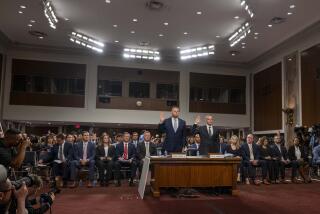Henry Kulbaski, 74; had copter shot down to protect White House
- Share via
Henry Kulbaski, a uniformed Secret Service agent who ordered an errant aircraft shot down over the White House in 1974, died of cancer June 17 at Geisinger hospital in Wilkes-Barre, Pa. He was 74.
Kulbaski was watch commander in the White House Executive Office control center in the predawn hours of Feb. 17, 1974, when he received word from the Maryland State Police that an Army helicopter had been stolen from Ft. Meade and was being chased into restricted air space near the White House.
As the purloined UH1B Huey helicopter circled the Washington Monument, Kulbaski watched and waited. President Nixon and his family were away, and Kulbaski was having difficulty reaching his superiors at 1 a.m.
“When no one answered, I knew I had to make the decision myself,” he told the Citizens Voice in Wilkes-Barre in 1994.
The helicopter buzzed the White House, then resumed circling the monument. If it came back, Kulbaski told the protective service agents on duty, be prepared to shoot it down.
When the copter headed toward the White House about 20 minutes later, Kulbaski gave the order. The copter “landed in a blaze of gunfire on the south lawn of the White House,” according to a 1974 article in the Washington Post.
The pilot, who had taken the state police on an erratic 50-mile journey through Maryland and into Washington, suffered superficial pellet wounds and was taken into custody.
Nixon later commended Kulbaski for issuing the order to down the helicopter.
An accomplished accordion player who specialized in polkas, Kulbaski was asked by First Lady Jacqueline Kennedy to play at White House parties for the president, which he did.
Kulbaski was born in Ashley, Pa. After serving in the Navy, where he primarily repaired helicopter rotors, Kulbaski moved to Buffalo, N.Y., where he worked for Bell Aircraft Corp., helping to assemble the Bell X-1, the first aircraft to break the sound barrier.
Kulbaski later moved to Washington and briefly worked in the D.C. Police Department. In 1958, he joined the Secret Service Uniformed Division. His service spanned six presidents, from Dwight D. Eisenhower to Jimmy Carter, before he retired as a lieutenant in 1978.
Survivors include his longtime companion, Shirley Carey; a sister; and a brother.
More to Read
Sign up for Essential California
The most important California stories and recommendations in your inbox every morning.
You may occasionally receive promotional content from the Los Angeles Times.













